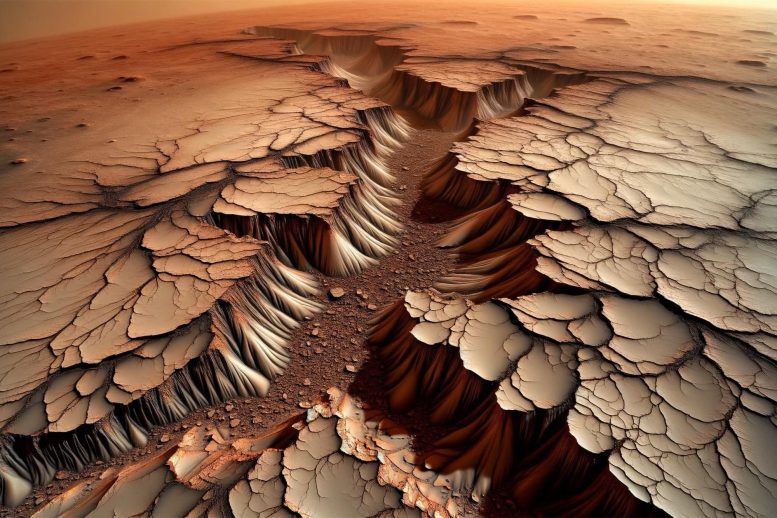
Researchers from the University of Oxford, in collaboration with international space agencies, determined that the largest-ever recorded Marsquake, S1222a, was caused by tectonic forces, not a meteorite impact, suggesting that Mars may be more seismically active than previously thought. (Artist’s concept of the aftermath of a Mars quake.)
A global collaboration led by the University of Oxford has determined that the largest-ever seismic event on Mars, known as S1222a, was not caused by a meteorite impact. Instead, the event, which was recorded by NASA’s InSight lander and lasted for over six hours, is believed to have been the result of enormous tectonic forces within Mars’ crust. This discovery suggests that Mars is more seismically active than previously believed, which could have implications for future habitation efforts on the planet. The results have been published on October 17 in the journal Geophysical Research Letters.
Background of the Marsquake Event
The quake, which had a magnitude of 4.7 and caused vibrations to reverberate through the planet for at least six hours, was recorded by NASA’s InSight lander on Wednesday, May 4, 2022. Because its seismic signal was similar to previous quakes known to be caused by meteoroid impacts, the team believed that this event (dubbed ‘S1222a’) might have been caused by an impact as well, and launched an international search for a fresh crater.
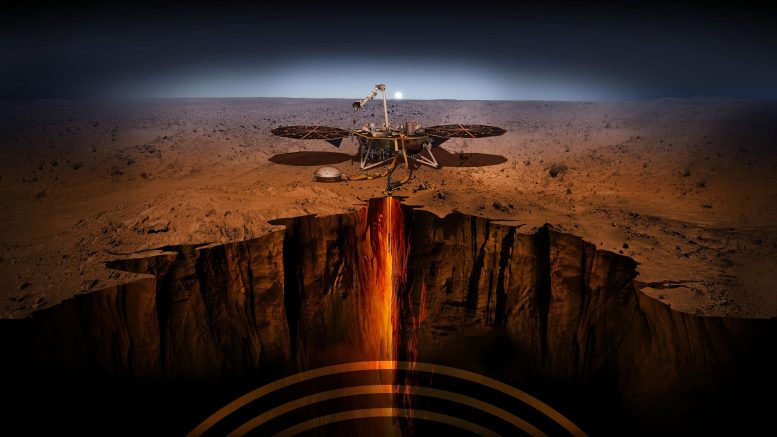
An artist’s illustration of the InSight lander on Mars. InSight, short for Interior Exploration using Seismic Investigations, Geodesy and Heat Transport, was designed to give the Red Planet its first thorough checkup since it formed 4.5 billion years ago. Credit: NASA/JPL-Caltech
Although Mars is smaller than Earth, it has a similar land surface area because it has no oceans. In order to survey this huge amount of ground – 144 million km2 – study lead Dr. Benjamin Fernando from the University of Oxford’s Department of Physics sought contributions from the European Space Agency, the Chinese National Space Agency, the Indian Space Research Organisation, and the United Arab Emirates Space Agency. This is thought to be the first time that all missions in orbit around Mars have collaborated on a single project.
Search for Evidence of Impact
During its time on Mars, InSight (which was co-designed by the University of Oxford) recorded at least 8 marsquake events caused by meteoroid impacts. The largest two of these formed craters around 150m in diameter. If the S1222a event was formed by an impact, the crater would be expected to be at least 300m in diameter. Each group examined data from their satellites orbiting Mars to look for a new crater, or any other tell-tale signature of an impact (e.g. a dust cloud appearing in the hours after the quake).
After several months of searching, the team announced that no fresh crater was found. They conclude that the event was instead caused by the release of enormous tectonic forces within Mars’ interior. This indicates that the planet is much more seismically active than previously thought.
“This project represents a huge international effort to help solve the mystery of S1222a, and I am incredibly grateful to all the missions who contributed. “I hope this project serves as a template for productive international collaborations in deep space.”
— Dr. Benjamin Fernando, Department of Physics, University of Oxford.
Dr. Fernando said: “We still think that Mars doesn’t have any active plate tectonics today, so this event was likely caused by the release of stress within Mars’ crust. These stresses are the result of billions of years of evolution; including the cooling and shrinking of different parts of the planet at different rates. We still do not fully understand why some parts of the planet seem to have higher stresses than others, but results like these help us to investigate further. One day, this information may help us to understand where it would be safe for humans to live on Mars and where you might want to avoid!”
Expert Views on the Discovery
Dr. Daniela Tirsch, Science Coordinator for the High Resolution Stereo Camera on board the European Space Agency’s Mars Express Spacecraft said: “This experiment shows how important it is to maintain a diverse set of instruments at Mars, and we are very glad to have played our part in completing the multi-instrumental and international approach of this study.”
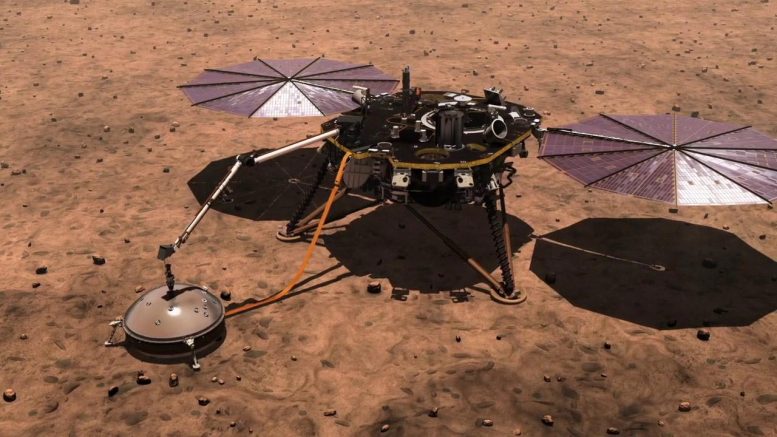
This illustration shows NASA’s Mars InSight lander on the Martian surface. Credit: NASA
From China, Dr. Jianjun Liu (National Astronomical Observatories, Chinese Academy of Sciences) added: “We are willing to collaborate with scientists around the world to share and apply this scientific data to get more knowledge about Mars, and are proud to have provided data from the color imagers on Tianwen-1 to contribute to this effort.”
Dr. Dimitra Atri, Group Leader for Mars at New York University Abu Dhabi and contributor of data from the UAE’s Hope Spacecraft, said: “This has been a great opportunity for me to collabrate with the InSight team, as well as with individuals from other major missions dedicated to the study of Mars. This really is the golden age of Mars exploration!”
Concluding Remarks and Future Directions
S1222a was one of the last events recorded by InSight before its end of mission was declared in December 2022. The team is now moving forward by applying knowledge from this study to future work, including upcoming missions to the Moon and Titan’s Moon Saturn.
Reference: “A Tectonic Origin for the Largest Marsquake Observed by InSight” by Benjamin Fernando, Ingrid J. Daubar, Constantinos Charalambous, Peter M. Grindrod, Alexander Stott, Abdullah Al Ateqi, Dimitra Atri, Savas Ceylan, John Clinton, Matthew Fillingim, Ernest Hauber, Jonathon R. Hill, Taichi Kawamura, Jianjun Liu, Antoine Lucas, Ralph Lorenz, Lujendra Ojha, Clement Perrin, Sylvain Piqueux, Simon Stähler, Daniela Tirsch, Colin Wilson, Natalia Wójcicka, Domenico Giardini, Philippe Lognonné and W. Bruce Banerdt, 17 October 2023, Geophysical Research Letters.
DOI: 10.1029/2023GL103619




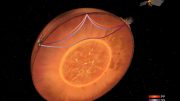
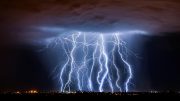



The last three words of the body of the article are transposed. Titan is Saturn’s moon.